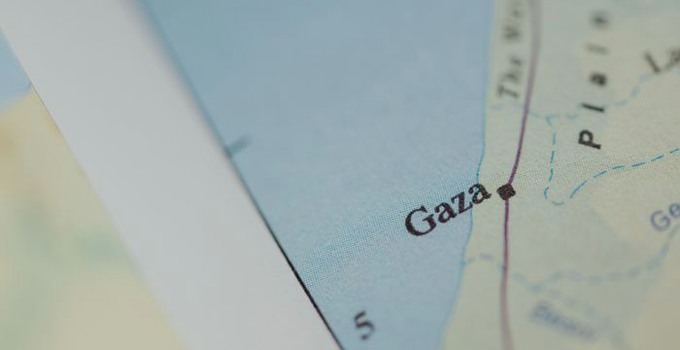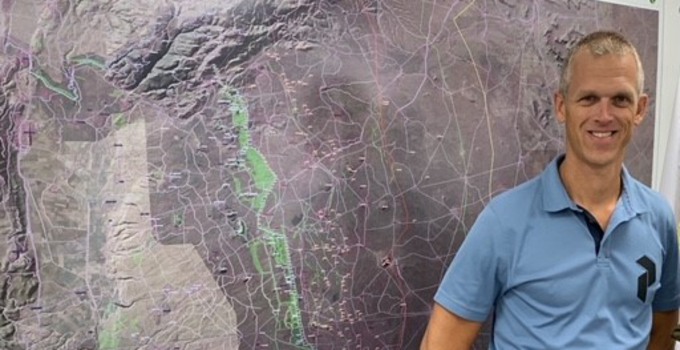
Anders Ekholm, Lieutenant Colonel and PhD student in War Studies. Photo: Anders G Warne
"The scarier scenario is a war on several fronts simultaneously"
Anders Ekholm researches operational art and examines the experiences of the Israeli Defence Forces. He has access to several sources in the region and is closely following the current situation after the Hamas terrorist attacks.
"Militarily, the biggest risk for Israel is along their northern border with Lebanon", he says.
Anders Ekholm's phone has been ringing almost non-stop since the large-scale attack on Israel by the Palestinian terrorist organization Hamas on October 7. As a Lieutenant Colonel in the Swedish Army and a Ph.D. student of Operational Art with a focus on Israel, his expertise is very much in demand to help us understand what is happening in the region.
"I am in contact with several sources on the ground whom I interviewed for my Ph.D. project. Many are generals in the Israeli army with great insight into what is happening now. Many also have long experience of previous conflicts in the region, but they say they have never seen this level of brutality before."
Hamas wants to provoke a counter-reaction
Anders Ekholm's analysis of the current situation in Israel is that Hamas has launched a bait to draw the world's attention to the region.
"By using the brutal violence we have witnessed, they are deliberately provoking a massive counter-reaction from Israel. Presumably, Hamas is trying to spur on its supporters and mobilize them for a multi-front war."
According to his sources, Israel wants to dismantle Hamas permanently to ensure that attacks of this kind cannot happen again.
"Right now, Israel is shaping the battlefield. They are cutting off electricity and water in Gaza and going in with airplanes and drones to take out as much of Hamas' capability as possible and turn the odds in their own favor."

The Gaza strip is 41 km long and between 6 and 12 km wide. Around two million people live here.
Disappearing opponents with the terrain on their side
Gaza is a very difficult environment for the Israeli army to enter. The area is densely populated, not only laterally but also in height and depth, with over two million inhabitants in a limited area. A ground operation requires extreme coordination, as the opponent uses the terrain to create traps that disperse the aggressor and thereby make them more manageable.
"Israel has extensive and expensive experiences from the past of going into this kind of area and fighting an opponent that we refer to as a disappearing opponent. Hamas has the terrain on its side and is well prepared. They also surround themselves with civilians and hostages."
Multi-front war
But despite the current situation, it is not what is happening in Gaza that we should be most worried about, says Anders Ekholm.
"It is of course an incredibly serious and life-threatening situation for those involved, but if we zoom out for a minute, the movements on the northern border with Lebanon are more dangerous."
An Israeli ground assault on Gaza could bring the Shia militia Hezbollah, with strong ties to Iran, into the war in full.
"Hezbollah is a much stronger, state-like actor with vast resources that can further escalate the violence. In military terms, the more dire scenario is a war on several fronts simultaneously, with the West Bank likely to be another theater or front."
Operational Art from an Israeli perspective
Anders Ekholm's research focuses on operational art, i.e. the thought process that translates military strategic and operational objectives into coordinated actions. He looks specifically at how to achieve operational or strategic depth, using the Israeli Defense Forces as a starting point.
"Depth can be described as the ability to capture an opponent's movements, recover, project one's own offensive ability, and shift between them and move on, he explains."
Traditionally, we talk about strategic or operational depth in the front or rear, but it can also be seen as the ability to sustain operations over time, known as temporal depth.
In his Ph.D. thesis, he analyzes strategic depth using a holistic thought model that encompasses a variety of parameters.
"What can be done with the available resources depends on several factors, such as the type of governance in the country you are operating in. Israel's legislation is different from ours and therefore offers different operational or strategic possibilities."
How Israel compensates for its limited geographical depth
He has chosen to focus on Israel, an actor that lacks physical strategic depth.
"The country is limited by its geography, and I am interested in how to create depth when the physical conditions pose restrictions."
To compensate for its geographical limitations, Israel has created an artificial depth, including extensive surveillance, early warning systems, and advanced air defences.
"But it seems that it didn’t work this time, perhaps they have relied too much on technology and turned complacent."
Learning from other’s experiences
Through extensive interviews with Israeli officers gathered during several research trips, he explores how the issue of strategic depth can be understood from their perspective based on their experiences.
"They take this very seriously because their decisions can have terrible consequences. They also have a way of looking at things that is different from us in the West."

Anders Ekholm has made several research trips to Israel and interviewed Israeli officers about their experiences. Photo: Private.
Anders Ekholm argues that Western defence forces are often too fixated on ideal models, where reality is forced to fit into a predetermined framework.
"I'm generalizing, but further east, like in the Israeli context, they see the world as constantly moving and embrace the idea that it cannot be controlled. Instead, they learn to go with the flow and find the potential in what is happening."
This involves constantly finding new strategies and never repeating yourself.
"Once a strategy has been applied in a practical operation successfully, it is considered exhausted and must not be used again. This is quite different from the way we think."
Bringing in new perspectives and learning from others' experiences is necessary to develop and stay relevant, says Ekholm.
"Military organizations are slow to change and tend to be traditionalist. There are many advantages to that, but it is equally important to adapt to new developments and not just look at how things were done during the Second World War, for example. From my perspective, operational art is not a linear product but is rather about cunning and the craft, how to analyze your own unit and your opponent and translate that into action."
He is coming to the end of his doctoral studies and has another year to go before presenting his thesis.
"When my thesis is ready, I aim to have a product that I can give back to the Swedish Armed Forces and that can provoke some new thoughts. We have a golden opportunity right now, when we are undergoing massive growth, to take the best from our previous experiences and build on it with new knowledge."
More about Operational Art
Operational Art is the thought process that translates military strategic and operational objectives into action. It aims to create multiple threats that present complex problems and chaos to the adversary. Operational Art connects military strategic objectives with tactical activities in joint operations.
Operational Art is applied to manage the use of combat forces in multiple time and space perspectives. The practice of operational art creates an understanding of what is to be achieved before the battle begins so that unnecessary confrontations can be avoided. Operational Art requires a broad understanding of the capabilities and limitations of combat forces and the operational environment.
The operational level provides a continuous and holistic overview to detect the developments and thus understand where and when adjustments and coordination are needed. In a joint operation, the time and space perspective are greater than in a single operation.
Source: The Swedish Armed Forces
Contact
More about
War StudiesPage information
- Published:
- 2023-10-20
- Last updated:
- 2025-06-30
